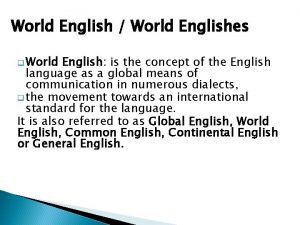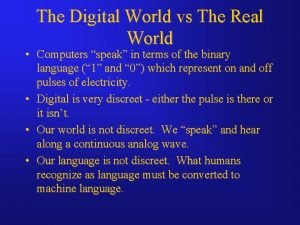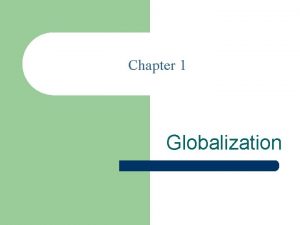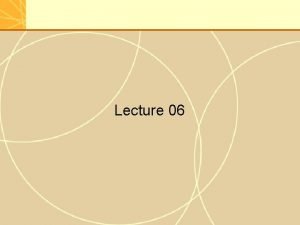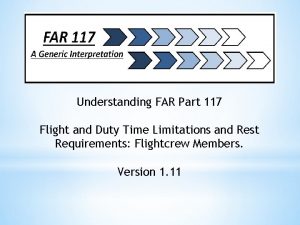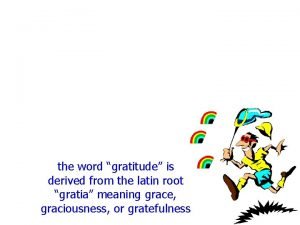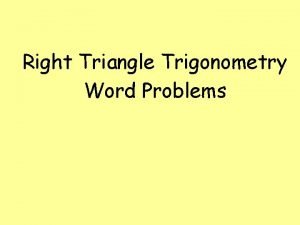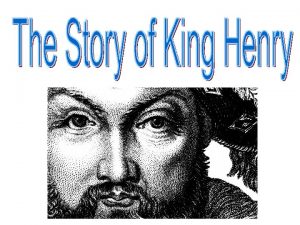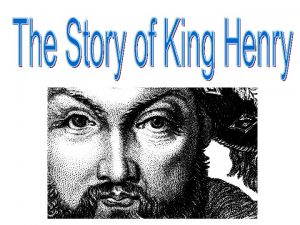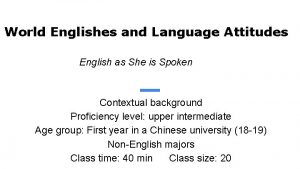DESCRIPTIVE MODELS OF WORLD ENGLISHES SO FAR DESCRIPTIVE





















![EXONORMATIVE STABILIZATION Linguistic effects [STLs] Borrowings (flora, fauna, culture-bound words) and their gradual incorporation EXONORMATIVE STABILIZATION Linguistic effects [STLs] Borrowings (flora, fauna, culture-bound words) and their gradual incorporation](https://slidetodoc.com/presentation_image_h/8f40b239b26d85cfbdbf0a1475f7b988/image-22.jpg)



















- Slides: 41

DESCRIPTIVE MODELS OF WORLD ENGLISHES SO FAR…

DESCRIPTIVE MODELS OF WORLD ENGLISHES 1. (1980)

DESCRIPTIVE MODELS OF WORLD ENGLISHES 2. Mc Arthur’s Circle of World Englishes (1987)

DESCRIPTIVE MODELS OF WORLD ENGLISHES 3. Katchru’s Three Overlapping Circles of Englishes (1988)

DESCRIPTIVE MODELS OF WORLD ENGLISHES 4. Modiano’s Centripetal Circles of International English (1999)

DESCRIPTIVE MODELS OF WORLD ENGLISHES 5. Modiano’s English as an International Language (1999)

DESCRIPTIVE MODELS OF WORLD ENGLISHES 6. Trudgill’s Developmental Model of Variety Formation (2004) better known as: Deterministic model

DESCRIPTIVE MODELS OF WORLD ENGLISHES 7. Graddol’s Community of English Model (2006)

DESCRIPTIVE MODELS OF WORLD ENGLISHES 8. Schneider’s Postcolonial Englishes (2007) 1 st phase: FOUNDATION 2 nd phase: EXONORMATIVE STABILIZATION 3 rd phase: NATIVIZATION 4 th phase: ENDONORMATIVE STABILIZATION 5 th phase: DIFFERENTIATION

World Englishes – descriptive models Edgar Schneider’s Dynamic Model - aims at all varieties of English, gives prominence to contact-language conditions as a crucial factor; taken into consideration historical periods/events accounts for such factors as indentity formation and other socio-psychological forces.

World Englishes – descriptive models Thomason’s influence: 1) importance of contact situations and its linguistic effects (codeswitching and code alternation, second-language acquisition strategies, bilingualism etc. ) Mfwene’s influence: 1) existence of a feature pool of possible lingustic choices 2) competition of features among the variants in the pool 3) founder effect 4) types of colonization

World Englishes – descriptive models diffusion of linguistic forms through “imperfect replication” speakers copy each other’s linguistic choices so they reproduce and transmit the elements of a language variety but they also recreate and appropriate them. Replication works both vertically (children copying their parents’ usage) and horizontally (speakers involved in the interaction influencing each other) In short Mufwane believes that new language varieties emerge in a competition-and-selection process between features available to speakers in a “feature pool” of possible linguistic choices. Moreover, speakers redefine and express their linguistic and social identity: - to align themselves with other individuals; as a consequence, to accomodate their speech behaviour to those they want to associate or be associated with.

World Englishes – descriptive models 1) 2) Mufwene identifies three types of colonization: Trade colonization: - sporadic contact (ex. : exchange of goods) - limited access to the lexifier, Exploitation colonies: - larger territories under European administration - clear social segregation and unequal power stratification - the lexifier is introduced in a scholastic form to a local elite to create a managerial group in-between the colonizers and the colonized

World Englishes – descriptive models 3) settlement colonization: - interactions between several varieties of a European source language with different backgrounds which produce different patterns of segregation (plantation settlement colonies = creolization) - continua of varieties marked by different degrees of reconstructuring - variants of the lexifier are adopted as the vernacular by coexistent communities

World Englishes – descriptive models Schneider: Importance of social identity and its construction and reconstruction by symbolic linguistic means. Humans associate to form groups because group membership offer some safety and comfort from potentially hostile and threatening world. Groups define and delimitate themselves by: - shared history, - shared set of beliefs and values - some form of outward appeareance including linguistic expression.

World Englishes – descriptive models Identities as not stable or clear-cut continuous rethinking and repositioning which also concerns the substitution of one symbolic form of expression by another multiplicity of social roles and identities (national, ethnic, class, profession, gender etc. ) hybrid identities

World Englishes – descriptive models The linguistic mechanism through which it is possible to achieve the symbolic expression of group identities is accomodation. social bond signalling is used to minimize linguistic differences so as to reflect social proximity (use of forms used by the communication partner to increase the set of shared features and avoidance of separating forms) Thomason calls this mechanism “negotiation” i. e. the speakers’ approximation of language to that of somebody else. Long process involving some sort of mutual alignment, both social and linguistic. crystallization of a newly emerging variety based on compromise – increase in the amount of shared features of the “feature pool” which will be frequently used and

World Englishes – descriptive models “The Evolution of PCEs is understood as a sequence of stages of identity rewritings and associated linguistic changes affecting the parties involved in a colonial-contact setting. Ultimately, the force behind this process is the reconstruction of the group identities so to who constitutes “us” or the other” by both settlers and indigenous residents in a given territory, reflected by associated socio-linguistic and linguistic processes. ” (Schneider, 29)

FOUNDATION Sociopolitical background Identity construction Sociolinguistic situation English is brought in the new territory (military forts/trading outposts) Clear-cut distinction between the two strands (‘us’ vs ‘others’) Reduced contact between the STLs and the INDp (few members, few purposes) Contact among different groups of STLs Marginal bilingualism (INDp)

FOUNDATION Linguistic effects Koinéization (within the STL strand) Pidginization Toponimic Borrowings (adoption/adaption)

EXONORMATIVE STABILIZATION Sociopolitical background Identity construction Sociolinguistic situation Settlers’ communities stabilize usually under British power (creation of colonies) Two contrasting attitudes (STLs) strong feeling of cultural belonging vs ‘British cum local identity’ INDp members of local community but segregational elitism arises because of the introduction of English Spread of bilingualism (INDp) Access to English: linguistic elitism – Schools – Interlanguage
![EXONORMATIVE STABILIZATION Linguistic effects STLs Borrowings flora fauna culturebound words and their gradual incorporation EXONORMATIVE STABILIZATION Linguistic effects [STLs] Borrowings (flora, fauna, culture-bound words) and their gradual incorporation](https://slidetodoc.com/presentation_image_h/8f40b239b26d85cfbdbf0a1475f7b988/image-22.jpg)
EXONORMATIVE STABILIZATION Linguistic effects [STLs] Borrowings (flora, fauna, culture-bound words) and their gradual incorporation Birth of –isms [INDs] grammar innovations (still unnoticed), Code-switching/mixing Creolization

NATIVIZATION Sociopolitical background movement towards political and personal independence Identity construction Both the STLs and the INDp consider theemselves as members of the same territory. Boundary is redrawn and progressively reduced Sociolinguistic situation Need for mutual accomodation (different attitudes in the STLs group) Second-language acquisition depending on ‘acculturation’ (integration in the target language) Linguistic norm is a big issue

NATIVIZATION Linguistic effects This stage is marked by linguistic convergence which will be stronger between the STLs and the IDN elites than between the STLs and the lower social strata of the IDG population. On the other hand, members of lower strata of the STLs are active agents in the transfer of features from the IDG strand.

NATIVIZATION Linguistic effects - - structural nativization consisting in the development of linguistic constructions peculiar to the new territory new word formation processes like derivations, compound, hybrid compounds localized collocations and set phrases different prepositional usage innovative assignments of verb complementation patterns to individual verbs; alternative morphosyntactic behaviour of some semanticallydefined word groups (stative vs active verbs; count vs non-count nouns code-switching/mixing as a sign of a new cultural orientation

Structural Nativization PHONOLOGY: Schneider: - diphthongs tend to get weakened or to lose their offglides altogether, and the number of short vowel contrasts is reduced; length differences between vowels are tend to become less important or not distinctive at all in many PCEs;

Structural Nativization PHONOLOGY: Platt, Weber and Ho: - shortening of vowels ex. caught = [ɔ: ] vs [ɔ] or [o] in many African languages; obliteration of the distinction between short and long vowels ex. hit [hɪt] vs heat [hi: t] became homophones [ɪ] in South-East Asian Englishes; replacement of central vowels by back or front vowels ex. purse = [pɜ: s] vs [pɜs] or [pɔs] respectively in West African Pidgins or AAVE; shortening or full ungliding of diphthongs ex. face = [feis] vs [fes] in the Caribbean, West Africa and South-East Asia replacement of dental fricatives with dental or alveolar stops: /ð/ this by /d/ dis in Indian and South African Englishes and of /θ/ think by /t/ tink in Jamaica

Structural Nativization PHONOLOGY: Platt, Weber and Ho: - reduction of aspiration word-initially in Indian English ex. time = [tʰaim] vs [taim] shifts of the main stress in complex words compared to British English; use of a syllable-timed rather than stress-timed speech rhythm in Maori English, most Asian, and many African and Caribbean varieties (sing-song quality)

Structural Nativization LEXIS 1) 2) 3) Borrowings from the IDG strand; Coinages using strategies of word formation Meaning adjustment of existing words to the new environmental conditions Borrowings: move from periphery to the centre place names = no real semantic denotation/one single item/no referential potential [phase 1] flora and fauna = they have referential potential because they refer to classes of objects/ more meaningful [phase 2] word related to indigenous culture = they entail semantic value

Structural Nativization Word Formation: same processes but different productivity As a general rule: Reduced productivity blends, clippings, acronyms VS Expanded Productivity compounding, especially hybrid compounds, and conversion

Structural Nativization Examples: a) words most widely used as determinatum: (Kenya) sportsmaster, drug master, housemaster b) agent noun formations: food maker, film goer, repeater c) hybrid compounds: autowallahs, paperwallah, policewallah d) gender-marking morphology: - lady as determinant: lady colleague, lady friend or lady as determinatum as inbusinesslady; use of suffix –(r)ess instructress, female temptress e) different lexicalization of the same object: petrol station (British English) gas(oline) station (American English, Phlippine English) petrol kiosk (Singapore English) petrol pump (Indian English)

Structural Nativization Collocational Preference and Idiomatic Phraseology: certain words co-occur preferably, and increasingly frequently, with certain other words Semantic Shift: the meaning of a word gets adjusted to new referential needs either by being narrowed down [corn = maize in Am. E] or widened [bush = wilderness in Aus. E]

Structural Nativization Grammar: different pattern distribution - some common grammatical phenomena based on the principle of simplification and second-language acquisition - linguistic variability also depends on social class and style stratification: - changes occur at the interface of language and lexis so some words or class of words prefer certain grammar rules or pattern.

Structural Nativization Some common differences include: omission of the nominal plural marker but pluralization of mass nouns; marking of a specific / non-specific distinction rather than definiteness in noun phrases (e. g. I’m staying in one house but Everyone has car in India); unusual constituent sequences within a noun phrase (this our common problem) omission of the third-person singular marker on verbs and use of present tense forms for the past tense delimitation of verbs with aspect rather than tense markers use of the progressive – ing with stative verbs

Structural Nativization - lack of inversion or of auxiliaries in wh-questions, e. g. You buy what? ; - multiple negation (also called ‘‘negative concord’’), e. g. I couldn’ t see no snake; - special forms or phrases for the second-person plural pronoun, e. g. y’ all (Southern US), yous (West Coast New Zealand), oonah / yinnah (Bahamas); - leveling of the functional distinction between present perfect and past tense, e. g. Then he’s hit her; - double comparatives and superlatives with adjectives, e. g. more brighter. - adverbs that are homomorphic with adjectives, e. g. an awful ill teacher;

Structural Nativization Changes at the crossroads of grammar and lexis: - New/different complementation verb and adjective patterns: - New/different lexical co-occurrences leading to collocational tendencies and eventually to idiom formation - to farewell somebody (from intr to tr) - different from, than, to - to pick somebody vs to pick up somebody (East Africa) - can’t stick the heat vs can’t stand the heat (South African Indian English) - make no bones about (do not hesitate - In. E)

ENDONORMATIVE STABILIZATION Sociopolitical background Identity construction Political independence is/has to be reached together with cultural self-reliance (gradual passage or X-event) Members of the STLs group perceive themselves as belonging to the newlyborn nation and their identity now includes also the IDG group The new identity construction is mainly based on the territory. Sometimes intentional “nation building”

ENDONORMATIVE STABILIZATION Sociolinguistic situation Linguistic effects Acceptance and adoption of local forms Recognition of the existence of the new language form (end of stigmatization) Passage form “English in X type” to “X English”. Higher cultural and linguistic independence (new literatures in English) New indigenous language variety is perceived as homogenous. Homogeneity is both real and partly imagined to strengthen group coherence. All members of the IDG strand have undergone a process of language shift and sometimes the indigenous languages are even extinct.

DIFFERENTIATION Sociopolitical background Emergence of a stable young country which has reached not only political, cultural and linguistic independence but also self-dependence. The new variety of English is regarded as something of the past so it is no longer a disputed issue. Internal differentiation based on econonic status, social categories and personal predilections

DIFFERENTIATION Identity construction The focus of an individual’s identity now shifts from the national to the community scale Internal heterogeneity arises masked by a collective identity (age, gender, ethnicity of a determined social group or stratum) Sociolinguistic situation Contacts are determined by the individual’s social networks which shape his/her interaction and guarantee mutual identification. Interaction and mutual identification result in group-internal linguistic accomodation.

DIFFERENTIATION Linguistic effects Birth of a new variety as a turning point for the stage of dialect birth. Social and regional variation. However, no monolingualism in English
 Lidia urban dictionary
Lidia urban dictionary World englishes definition
World englishes definition Jennifer jenkins world englishes
Jennifer jenkins world englishes Exonormative stabilization
Exonormative stabilization World englishes a resource book for students
World englishes a resource book for students Open handed map in elementary school
Open handed map in elementary school An elementary school classroom in a slum rhyme scheme
An elementary school classroom in a slum rhyme scheme In a kingdom far far away
In a kingdom far far away Far far away city
Far far away city Difference between model and semi modals
Difference between model and semi modals Old vs new world monkeys
Old vs new world monkeys Are oranges old world or new world
Are oranges old world or new world Real world vs digital world
Real world vs digital world Plato on reason
Plato on reason Ap world history chapter 25 africa and the atlantic world
Ap world history chapter 25 africa and the atlantic world The changing world output and world trade picture
The changing world output and world trade picture Dangerous world tour history world tour - hockenheimring
Dangerous world tour history world tour - hockenheimring English world 1 unit 9
English world 1 unit 9 The changing world output and world trade picture
The changing world output and world trade picture Char far in c
Char far in c Fdp table b
Fdp table b Far side spider slide
Far side spider slide Map of the vikings travels
Map of the vikings travels Far side rocket scientist
Far side rocket scientist Great gatsby questions chapter 3
Great gatsby questions chapter 3 Apa cover page.
Apa cover page. Banter vs bullying examples
Banter vs bullying examples Spider man far from home blockbuster
Spider man far from home blockbuster Word problems using right triangle trig
Word problems using right triangle trig Slidetodoc
Slidetodoc Past simple kolona
Past simple kolona New words to learn
New words to learn Far 117 table b
Far 117 table b Far out of the money options
Far out of the money options Gone too far childnet
Gone too far childnet Once in a faraway city
Once in a faraway city King henry chocolate milk story
King henry chocolate milk story Nn vikings
Nn vikings How far is the high school free throw line
How far is the high school free throw line Media access control in mobile computing
Media access control in mobile computing Gro far
Gro far Love lifted me images
Love lifted me images



